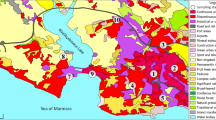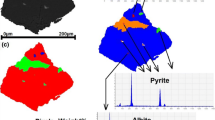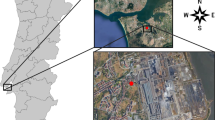Abstract
A multi-stage particle sampling instrument and a particle counter were operated at the ground monitoring site in Fukuoka where was directly exposed to the outflow of air masses from the Asian continent during the springtime of 2005. The bulk and individual dust particles were analyzed simultaneously by ICP-MS and micro-PIXE, respectively. The ground-based observation of dust storm by the Japan Meteorological Agency and by the NOAA HYSPLIT dispersion-trajectory model indicated that dust storm was driven from the Chinese continent including dust source area. The number concentration of gigantic particles (e.g., larger than 5 μm) was measured to be 10 times higher in an Asian dust storm (hereafter called “ADS”) period than in a non-ADS period. There is an outstanding increase of mass concentration in the range of 3.5–7.7 μm in ADS event. In ADS event, soil fraction accounts 57.9–70.1% of particle mass concentration in coarse particles larger than 3.5 μm. Micro-PIXE analysis enables us to classify individual dust particles into several types. The particles with 3.5–5.1, 5.1–7.7, and 7.7–10.9 μm experienced aging processes by 60.6, 69.2, and 77.2%, respectively. On the basis of the reconstructed elemental maps by micro-PIXE analysis, the chemical transformation of dust particles was also presumed.










Similar content being viewed by others
References
Andreae, M. O., Charlson, J. C., Bruynseels, F., Storms, H., Van Grieken, R., & Maenhant, W. (1986). Science, 232, 1620.
Braaten, D. A., & Cahill, T. A. (1986). Atmospheric Environment, 20, 1105.
Draxler, R. R., & Rolph, G. D. (2003). HYSPLIT (HYbrid Single-Particle Lagrangian Integrated Trajectory) model access via NOAA ARL READY. Silver Spring, MD: NOAA Air Resources Laboratory. Retrieved from (http://www.arl.noaa.gov/ready/hysplit4.html).
Duce, R. A., Unni, C. K., Ray, B. J., Prospere, J. M., & Merrill, J. T. (1980). Science, 209, 1522.
Friedlander, S. K. (1977). Smoke, dust, and haze: Fundamentals of aerosol behavior. New York: Wiley (p. 317).
Johansson, S. A. E., Campbell, J. L., & Malmqvist, K. G. (1995). New York: Wiley (p. 111).
Kasahara, M., Park, J. H., & Chatani, S. (1996). International Journal of PIXE, 6, 299.
Kim, K. H., Choi, G. H., Kang, C. H., Lee, J. H., Kim, J. Y., Youn, Y. H., et al. (2003). Atmospheric Environment, 37, 753.
Ma, C. J., Kasahara, M., Tohno, S., & Hwang, K. C. (2001). Atmospheric Environment, 35, 747.
Ma, C. J., Tohno, S., Kasahara, M., & Hayakawa, S. (2005). Atmospheric Environment, 39, 739.
Ohta, S., & Okita, T. (1990). Atmospheric Environment, 24A, 815.
Olesik, J. W. (1996). Analytical Chemistry, 68, 469A.
Rolph, G. D. (2003). Real-time Environmental Applications and Display sYstem (READY) Silver Spring, MD: NOAA Air Resources Laboratory. Retrieved from (http://www.arl.noaa.gov/ready/hysplit4.html).
Sakai, T., Hamano, T., Kamiya, T., Murozono, K., Inoue, J., Matsuyama, S., et al. (1998). Nuclear Instruments & Methods in Physics Research. Section B, 136, 390.
Song, C. H., & Carmichael, G. R. (1999). Atmospheric Environment, 33, 2203.
Wang, X., & Guanghua, Z. (1996). International Journal of PIXE, 6, 361.
Zhang, X. Y., Gong, S. L., Zhao, T. L., Arimoto, R., Wang, Y. Q., & Zhou, Z. J. (2003). Geophysical Research Letters, 30, 2272. Retrieved from doi:10.1029/2003GL018206.
Zhang, D., & Iwasaka, Y. (1998). Journal of Aerosol Science, 29, S217.
Acknowledgements
This study was supported in part by the Dong-A University Research Fund in 2005. The authors gratefully acknowledge the NOAA Air Resources Laboratory (ARL) for the provision of the HYSPLIT transport and dispersion model and/or READY website (http://www.arl.noaa.gov/ready.html) used in the present study. The authors also express sincere thanks to M.-S. Park who is a Ph D student in the Division of Earth and Environmental Engineering, Dong-A University and S. Yoshitake who is an alumna of the Department of Environmental Science, Fukuoka Women’s University for their sampling and analyzing support.
Author information
Authors and Affiliations
Corresponding author
Rights and permissions
About this article
Cite this article
Ma, CJ., Choi, KC. A Combination of Bulk and Single Particle Analyses for Asian Dust. Water Air Soil Pollut 183, 3–13 (2007). https://doi.org/10.1007/s11270-006-9302-z
Received:
Accepted:
Published:
Issue Date:
DOI: https://doi.org/10.1007/s11270-006-9302-z




